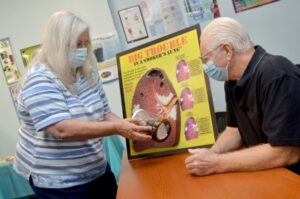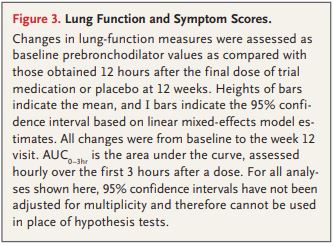
In 2020, Charlene Rees, a nurse educator at Naval Hospital Jacksonville’s Wellness Center, educated retired Army servicemember Larry Cantrell during a smoking cessation class. Questions have been raised about treatment of smoking-related lung symptoms. U.S. Navy photo by Jacob Sippel, Naval Hospital Jacksonville
ANN ARBOR, MI ― Long-term smokers often have serious respiratory symptoms, but without airflow obstruction. A new study questioned whether those patients should be treated with drugs used for chronic obstructive pulmonary disease (COPD).
In a potentially practice-changing discovery, the authors found that inhaled dual bronchodilator therapy did not decrease respiratory symptoms in smokers with preserved lung function as assessed by spirometry. The National Heart, Lung and Blood Institute (NHLBI) reported that about 20-40% of adults with COPD symptoms but who aren’t diagnosed with COPD use these types of long-lasting inhalers.
University of Michigan authors and colleagues pointed out that the patients often are treated with medications for COPD, even though supporting evidence for the therapy remained inconclusive. Participating in the study were researchers from San Francisco VA Healthcare System, VA Medical Center in White Rover Junction, VT; and the Minneapolis VA Healthcare Center, where much of the trial was conducted.
In the study reported in the New England Journal of Medicine, the research team randomly assigned a cohort of 535 tobacco smokers to receive either indacaterol (27.5 μg) plus glycopyrrolate (15.6 μg) or a placebo twice daily for 12 weeks. Participants had smoked at least 10 pack-years, had respiratory symptoms as defined by a COPD Assessment Test score of at least 10 (scores range from 0 to 40, with higher scores indicating worse symptoms) and preserved lung function on spirometry (ratio of forced expiratory volume in 1 second [FEV1] to forced vital capacity [FVC] ≥0.70 and FVC ≥70% of the predicted value after bronchodilator use.)1
Defined as the primary outcome was at least a 4-point decrease (i.e., improvement) in the St. George’s Respiratory Questionnaire (SGRQ) score (scores range from 0 to 100, with higher scores indicating worse health status) after 12 weeks without treatment failure. For purposes of the study, treatment failure was defined as an increase in lower respiratory symptoms treated with a long-acting inhaled bronchodilator, glucocorticoid, or antibiotic agent.
After randomization, in the modified intention-to-treat population of 471 participants, 128 of 227 participants (56.4%) in the treatment group and 144 of 244 (59.0%) in the placebo group had at least a 4-point decrease in the SGRQ score (difference, -2.6 percentage points; 95% confidence interval [CI], -11.6 to 6.3; adjusted odds ratio, 0.91; 95% CI, 0.60 to 1.37; P=0.65), according to the study.
The researchers calculated the mean change in the percent of predicted FEV1 as 2.48 percentage points (95% CI, 1.49 to 3.47) in the treatment group and -0.09 percentage points (95% CI, -1.06 to 0.89) in the placebo group. The mean change in the inspiratory capacity was 0.12 liters (95% CI, 0.07 to 0.18) in the treatment group and 0.02 liters (95% CI, -0.03 to 0.08) in the placebo group. They note that four serious adverse events occurred in the treatment group, and 11 occurred in the placebo group; although none were deemed potentially related to the treatment or placebo.
No Symptom Decrease
“Inhaled dual bronchodilator therapy did not decrease respiratory symptoms in symptomatic, tobacco-exposed persons with preserved lung function as assessed by spirometry,” the authors concluded.
“We’ve assumed these medications worked in patients who don’t meet lung function criteria for COPD, but we never checked,” MeiLan K. Han, MD, a principal investigator and first author of the study, said in a NHLBI press release. “We now know these existing medications don’t work for these patients.”
The findings have special significance at the VA. During 2010-2015, more than 1 in 5 (21.6%) veterans in the United States reported being current cigarette smokers. In 2018, 14.6% of veterans enrolled for care reported being a current cigarette smoker. In addition, about one-fourth of VHA patients have been diagnosed with some form of COPD, according to the American Lung Association, and often present with lung issues earlier than civilians.
Background information in the NEJM article pointed out that COPD is defined by a reduced ratio of forced expiratory volume in 1 second (FEV1) to forced vital capacity (FVC) after bronchodilator use. “However, we previously found that some tobacco-exposed persons who have preserved lung function as assessed by spirometry report having substantial respiratory symptoms, activity limitation, and exacerbations, similar to those in persons with airflow obstruction measured on spirometry,” the authors explained. “These tobacco-exposed persons with preserved lung function on spirometry who have respiratory symptoms as defined by a COPD Assessment Test (CAT) score of 10 or greater (scores range from 0 to 40, with higher scores indicating worse symptoms) also have airway-wall thickening and higher sputum mucin concentrations than non-symptomatic persons.”
Other studies, they added, have shown that those with tobacco exposure sometimes have respiratory impairments and abnormalities on computed tomography (CT), such as emphysema and air-trapping.
“Many symptomatic tobacco-exposed persons with preserved lung function on spirometry are treated with COPD medications, including inhaled bronchodilators and glucocorticoids,” the researchers noted. “Because spirometry is infrequently performed in primary care, it is unclear whether physicians believe they are treating COPD or whether they believe COPD medications are effective for these patients. Regardless, randomized trials to guide treatment in this patient population are lacking.”
“In response to this evidence gap, we hypothesized that persons who currently or formerly smoked cigarettes with at least a 10-pack-year history and who have clinically
spirometry (i.e., FEV1:FVC ≥0.70 and FVC ≥70% of the predicted value) would benefit from treatment with inhaled bronchodilators.”
- Han MK, Ye W, Wang D, White E, et. al. RETHINC Study Group. Bronchodilators in Tobacco-Exposed Persons with Symptoms and Preserved Lung Function. N Engl J Med. 2022 Sep 29;387(13):1173-1184. doi: 10.1056/NEJMoa2204752. Epub 2022 Sep 4. PMID: 36066078.



